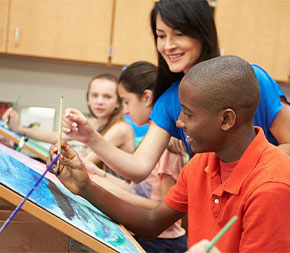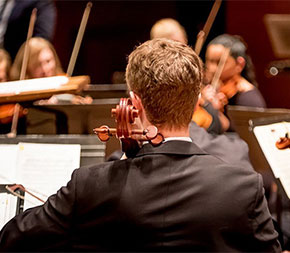Explore Your Creative Side by Becoming an Art Teacher


If you are an artist who wants to share your talent with the next generation, teaching art at a public school as a staff art teacher might be your dream job. Seeing young students improve their skills and find their own creative voice is incredibly satisfying for any teacher. But before beginning your art teacher career, the first step is to get a degree in art education.
The Art of Teaching Art
A typical day in the life of an art teacher may begin with a general art education class for third graders, and the next hour may involve working with a group of high schoolers to make an animated short film or shoot a movie on an iPhone. But life as an art teacher is not all paint and paper. Here are some duties and activities that art teachers do on a typical day:
- Planning class projects and assignments
- Ordering and maintaining supplies
- Grading assignments and monitoring student achievement
- Maintaining classroom discipline
- Familiarizing students with well-known artists and art history
- Filing administrative paperwork
- Attending staff and teacher meetings
- Meeting with parents
In a community college or university setting, both full-time and adjunct teachers are usually required to attend meetings, keep office hours and complete other administrative tasks in addition to classroom time.
In the Classroom
Most students love to come to art class. Some might see it as “fun” rather than “work,” so maintaining discipline may be more difficult than in most classrooms. But patience, organization and a sense of humor are all tools that come in handy for an art teacher. When the day is done, it is always rewarding to see students’ creativity develop.
Post-secondary art teachers don’t face the same challenges, but an art teaching job at a community college may be more difficult to come by and pay less than full-time public school jobs. Many college art teachers are part-time or adjunct, teaching to supplement their art careers.
Education and Degrees
To land an art teacher job in a public primary or secondary school, you must have an art education degree as well as a state or national teaching certificate. Some states require teachers to complete a post-graduate art education degree as well to fulfill certificate requirements. Check with your state’s Department of Education to see what the requirements are in your area. Only master’s program, PhD or EdD graduates are considered for art teacher jobs in community colleges or universities.
Choosing a Program
There are hundreds of art education programs available throughout the country, making the choice of one over the others a real challenge. There are a few considerations that need to take priority. First and foremost is the location of the program. Are you willing to relocate, or do you want to stay where you are? In either case, an online or hybrid program might expand your options. Second, you need to consider cost. Education is important, but you don’t want to jeopardize your financial future by going deep into debt. Keep in mind that teachers typically earn a fair, but not generous, salary. Think about what you are realistically able to spend, and consider financial aid options before you start taking out loans.
Once your list of choices is narrowed down, it’s time to consider curriculum. You will want to attend a program that offers classes that generally interest you. They could be focused on a specific artistic discipline or offer in-depth, hands-on training. It is important to remember, however, that, as an art teacher, your job is not to pass along your own interests but rather to foster the interests of your students. If you focus too heavily on one discipline or subject, it could compromise your ability to competently teach other disciplines or subjects.
Finally, think about what kind of students you want to teach. The age of the students is obviously a big factor. There tends to be a larger number of art teachers working in elementary school settings, but jobs in high schools and colleges offer you a chance to work with more accomplished young artists. There are also students with special needs to consider. Some highly specialized art teachers even offer a form of therapy though creative expression. Think about what you really want from your teaching career, and seek out a program that puts you on the path you want to be on.
Art and Core Competency Exams
After finishing your degree, you will need to pass an exam to demonstrate that you have the necessary skills to teach art effectively. These tests are different in every state but share some common characteristics. Usually, they will have one extensive section covering general teaching topics and another focused on topics specific to arts education.
Though it varies by state, many states rely on an exam called the Praxis Art: Content Knowledge test. This test includes 120 questions and is administered over a period of two hours. The test questions are broken up into categories covering the media and process of art making, as well as the history and theoretical foundations of art.
Art teachers who choose to work with specialized student populations or provide specialized forms of instruction may be required to complete additional exams. Keep in mind as well that passing these exams simply qualifies an art teacher to work. In order to secure a job, a teacher may need to take further steps to demonstrate skill or expertise.
Apply for a State License
The final step before becoming an art teacher is applying for and being granted a state license. Since teaching is so fundamental to development, and teachers work with potentially vulnerable populations of young people, they need to be carefully vetted and endorsed before being allowed to work. That is why all states require teachers, including art teachers, to have a license. Each state also sets its own requirements for licensure.
Typically, the requirements for getting a license mandate that the potential art teacher have a prescribed mixture of education, experience and test scores. If you have already completed a degree and passed your core competency exams, you are well on your way to meeting the requirements for a license. Many students plan out their educational path so that they are eligible for licensure as soon as possible after graduation. Art teachers will also need to pass a criminal background check, and in some states, will need to prove citizenship.
It is possible to start working after earning a state license, but some teachers elect to earn additional licenses either before or after they get into the classroom. National organizations like the National Board for Professional Teaching Standards and The American Board for Certification of Teacher Excellence both offer certificate programs. These do not replace state licensure, but they do demonstrate initiative and a commitment to excellence on the part of an art teacher. Earning one or both of these certificates is a good way to advance an already established career in art education.



